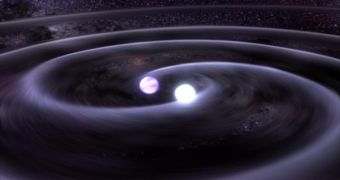In a paper to be published in an upcoming issue of the esteemed Astrophysical Journal Letters, a team of astronomers provides the first evidence that gravitational waves indeed exist. What's even more impressive, the motions that were caused by these waves were observed at optical wavelengths.
The study that led to this discovery was conducted on a binary star system made up of two white dwarfs. A white dwarf is the helium-burning nucleus of a former Sun-sized star, which shed its outer atmosphere, and depleted its hydrogen reserves.
Experts found such a system, awarded the catchy name SDSS J065133.338+284423.37, using a number of telescopes in Texas, Hawaii, New Mexico, and the Canary Islands, including the McDonald Observatory, MMT Observatory, the Gemini North Telescope, and Gran Telescopio Canarias.
The reason why this study was made possible is that the two white dwarfs are orbiting each other once every 13 minutes, which means that they are very close to each other.
Given the huge gravitational pull they exert from such a short distance, they can warp the fabric of spacetime around them, an effect that was originally proposed by Albert Einstein's theory of general relativity, nearly a century ago.
Thus far, many attempts have been made at detecting these waves, but this is the first set of observations to be conducted at optical wavelength, and succeed, Space reports.
According to a statement by Smithsonian Astrophysical Observatory (SAO) astronomer Warren Brown, this was “the cleanest and strongest detections of the effect of gravitational waves” ever made.
One of the main ideas in gravitational wave theory is that these distortions in spacetime would carry energy away from a massive structure – like a binary system – forcing its stars to draw ever closer to each other, at the same time increasing their orbital speed.
This is exactly the effect the team observed. “Compared to April 2011, when we discovered this object, the eclipses now happen six seconds sooner than expected,” University of Oklahoma astronomer Mukremin Kilic explains.
These results are in tune with theoretical predictions, which is a major astronomical discovery. At the same time, the findings also certify that studies conducted at optical wavelengths can indeed detect the production of gravitational waves, something that was uncertain until now.

 14 DAY TRIAL //
14 DAY TRIAL //